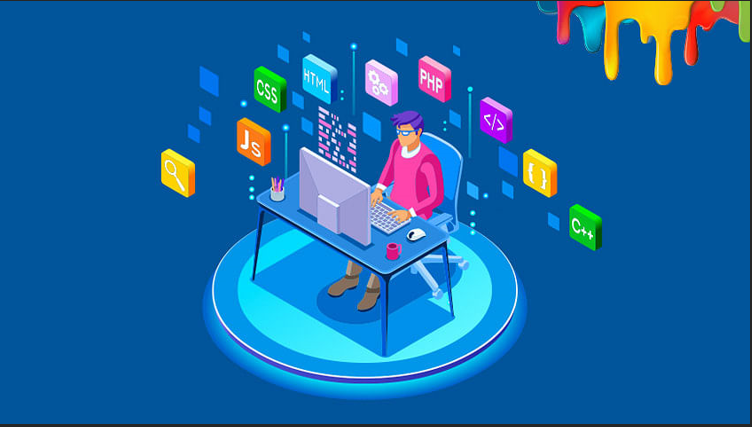Bridging Front-End and Back-End: Full Stack Development Demystified
Introduction
In the ever-evolving landscape of web development, Full Stack Development has emerged as a key skillset, sought after by businesses and organizations worldwide. Full Stack Developers are the Swiss Army knives of the digital world, capable of handling both the front-end and back-end aspects of web applications. But what exactly does it mean to bridge the gap between these two domains? In this comprehensive guide, we will demystify Full Stack Development, explore its importance, and equip you with the knowledge to embark on your journey as a Full Stack Developer.
Understanding Full Stack Development
Defining Front-End and Back-End
Before delving into Full Stack Development, it’s essential to comprehend the fundamental components: front-end and back-end.
Front-End: Front-end development, also known as client-side development, involves everything that users see and interact with on a website or web application. It encompasses the visual elements, user interface, and user experience. Key technologies in front-end development include HTML (HyperText Markup Language), CSS (Cascading Style Sheets), and JavaScript.
Back-End: Back-end development, or server-side development, is responsible for the server, databases, and server applications that work behind the scenes to make the front-end of a website or application function. It deals with data processing, security, and ensuring that the application runs smoothly.
The Role of a Full Stack Developer
A Full Stack Developer is someone who has proficiency in both front-end and back-end development. They are versatile professionals who can take a project from conception to completion, handling every aspect of the development process. The role of a Full Stack Developer is to bridge the gap between the front-end and back-end, ensuring seamless communication between the two.
Full Stack Developers possess a broad skill set that allows them to:
- Design user-friendly and responsive interfaces.
- Develop server applications and manage databases.
- Troubleshoot and debug issues in both front-end and back-end components.
- Optimize performance and security.
- Work effectively in diverse development environments.
In the next sections, we will explore the technologies and tools that Full Stack Developers commonly use to fulfill these responsibilities.
Front-End Technologies and Tools
HTML, CSS, and JavaScript
HTML, CSS, and JavaScript are the foundational technologies of front-end development.
- HTML (HyperText Markup Language): HTML is used to structure web content. It defines the elements and layout of a web page, from headings and paragraphs to images and links.
- CSS (Cascading Style Sheets): CSS is responsible for styling and layout. It controls the visual presentation of HTML elements, including colors, fonts, spacing, and responsiveness.
- JavaScript: JavaScript adds interactivity to web pages. It enables features like dynamic content, form validation, and real-time updates. Popular JavaScript libraries and frameworks like jQuery, React, and Angular provide additional functionality.
Front-End Frameworks
Front-end frameworks streamline the development process by offering pre-built components and templates. Some popular front-end frameworks include:
- Bootstrap: A widely used framework for creating responsive, mobile-first websites. It provides a library of CSS and JavaScript components.
- React: Developed by Facebook, React is a JavaScript library for building user interfaces. It’s known for its component-based architecture and virtual DOM, which enhances performance.
- Angular: An open-source framework by Google, Angular offers a robust structure for building dynamic web applications.
Responsive Design
Responsive design is a crucial aspect of front-end development. It ensures that websites adapt to various screen sizes and devices, providing an optimal user experience. Cascading Style Sheets (CSS) media queries are used to implement responsive design, adjusting the layout and content based on the user’s device.
Incorporating these technologies and principles, front-end developers create visually appealing and user-friendly interfaces. Now, let’s move on to the back-end technologies and tools.
Back-End Technologies and Tools
Server-Side Programming Languages
Back-end development involves working with server-side programming languages to build the logic and functionality of web applications. Common back-end programming languages include:
- Python: Known for its simplicity and versatility, Python is often used for web development, and frameworks like Django and Flask make it a solid choice.
- Ruby: Ruby on Rails is a popular framework for building web applications. It emphasizes convention over configuration, simplifying development.
- JavaScript (Node.js): Node.js enables server-side JavaScript development, making it seamless for Full Stack Developers to use JavaScript on both ends of a project.
- Java: Java is renowned for its reliability and scalability, making it a preferred choice for large-scale applications.
- PHP: PHP has been a staple in web development for years and is commonly used with databases like MySQL.
Databases and Data Storage
Back-end developers are responsible for managing and querying databases to store and retrieve data. Common databases used in web development include:
- MySQL: A popular open-source relational database management system (RDBMS) used for storing structured data.
- MongoDB: A NoSQL database that excels at handling unstructured or semi-structured data, making it suitable for certain types of applications.
- PostgreSQL: Another open-source RDBMS that is known for its extensibility and advanced features.
- SQLite: A lightweight, file-based database often used in mobile and small-scale applications.
Server Deployment and Management
To ensure that web applications run smoothly, back-end developers need to deploy and manage servers. This involves tasks like configuring server environments, setting up security measures, and handling server maintenance.
Server deployment options range from traditional on-premises servers to cloud-based services like Amazon Web Services (AWS), Microsoft Azure, and Google Cloud Platform (GCP). These cloud platforms provide scalable infrastructure for hosting web applications.
Now that we have covered the key front-end and back-end technologies and tools, let’s explore how Full Stack Developers bridge the gap between these domains.
Bridging the Gap: Full Stack Development Frameworks
Bridging the gap between front-end and back-end development is made more efficient through the use of Full Stack Development frameworks. These frameworks provide a cohesive and integrated environment for developing, deploying, and maintaining web applications. Some popular Full Stack Development frameworks include:
Popular Full Stack Development Frameworks
- MEAN Stack: MEAN is an acronym for MongoDB, Express.js, Angular, and Node.js. It is a Full Stack Development framework that uses JavaScript for both the front-end and back-end, making it highly efficient for developers who are well-versed in JavaScript.
- MERN Stack: Similar to MEAN, the MERN Stack includes MongoDB, Express.js, React, and Node.js. React is used on the front-end to create dynamic user interfaces.
- Django: Django is a high-level Python framework that encourages rapid development and clean, pragmatic design. It simplifies many aspects of web development, including authentication and database modeling.
- Ruby on Rails: Ruby on Rails is a robust Full Stack framework for Ruby. It promotes the use of convention over configuration, which accelerates development by reducing the need for extensive coding.
Benefits of Using Frameworks
Full Stack Development frameworks offer several advantages, including:
- Consistency: Frameworks provide a structured approach to development, ensuring consistent coding practices across both the front-end and back-end.
- Modularity: Modular components and libraries within frameworks make it easy to integrate new features and functionalities into web applications.
- Efficiency: Frameworks come with built-in tools for common tasks, such as authentication and database management, reducing the time needed for development.
- Community Support: Frameworks often have active developer communities, which means you can find resources, tutorials, and solutions to common issues more easily.
By adopting a Full Stack Development framework, you can expedite the development process and streamline the collaboration between front-end and back-end developers.
The Full Stack Development Workflow
A Full Stack Developer’s workflow encompasses various stages, from project planning to deployment and maintenance.
Project Planning and Design
The development process typically begins with project planning and design. Full Stack Developers collaborate with stakeholders to define the project’s goals, requirements, and objectives. During this phase, they create wireframes and mockups to visualize the application’s layout and user interface.
Development and Testing
Once the project plan and design are finalized, Full Stack Developers move on to the development stage. They start by implementing the front-end design, building user interfaces, and ensuring responsiveness. Simultaneously, they work on the back-end, setting up databases, creating server applications, and integrating business logic.
Testing is an integral part of development, involving both manual and automated testing to identify and rectify issues. Full Stack Developers must ensure that the application works seamlessly on various devices and browsers.
Deployment and Maintenance
After thorough testing, the application is ready for deployment. Full Stack Developers manage the deployment process, configuring servers and ensuring that the application is accessible to users. Once the application is live, ongoing maintenance is essential to address bug fixes, updates, and security concerns.
Challenges and Pitfalls of Full Stack Development
While Full Stack Development is a rewarding field, it comes with its own set of challenges and pitfalls. Let’s explore some of the common issues faced by Full Stack Developers.
Maintaining Skill Proficiency
Full Stack Developers are expected to stay up-to-date with an ever-evolving tech landscape. This can be a daunting task, as they need to keep pace with advancements in both front-end and back-end technologies. Continuous learning and professional development are essential to address this challenge.
Balancing Workload
Full Stack Developers often handle multiple responsibilities simultaneously. Balancing the demands of both front-end and back-end development, along with project management tasks, can be challenging. Effective time management and prioritization skills are crucial.
Security and Scalability Concerns
Ensuring the security and scalability of web applications is a critical aspect of Full Stack Development. A breach in security or poor scalability can have serious consequences. Full Stack Developers must be well-versed in best practices for secure coding and have a good understanding of infrastructure scaling.
Resources for Learning Full Stack Development
If you’re interested in becoming a Full Stack Developer or enhancing your skills, there are plenty of resources available:
Online Courses and Tutorials
Numerous online courses and tutorials cover Full Stack Development. Platforms like Coursera, edX, Udemy, and freeCodeCamp offer courses that range from beginner to advanced levels.
Books and Documentation
Consider reading books on Full Stack Development, front-end, and back-end technologies. Documentation for popular frameworks, languages, and tools is also an invaluable resource.
Building Your Portfolio
Practice is essential. Create your projects to build a portfolio showcasing your skills. This not only helps you learn but also provides evidence of your abilities to potential employers or clients.
Conclusion
Full Stack Development is a multifaceted field that demands versatility, continuous learning, and a deep understanding of both front-end and back-end technologies. As a Full Stack Developer who has completed a Full Stack Development course in Mathura, Noida, Delhi, Gurgaon, Roorkee, Ahamdabad and other cities in India. you have the unique ability to build complete web applications, from the user interface to the server infrastructure. While the journey may be challenging, the rewards are substantial.
By mastering the skills and concepts presented in this guide and staying engaged with the evolving tech landscape, you can embark on a successful career in Full Stack Development, contributing to the creation of innovative and user-friendly web applications. As the bridge between the front-end and back-end, you play a pivotal role in the world of web development, helping bring digital visions to life.















